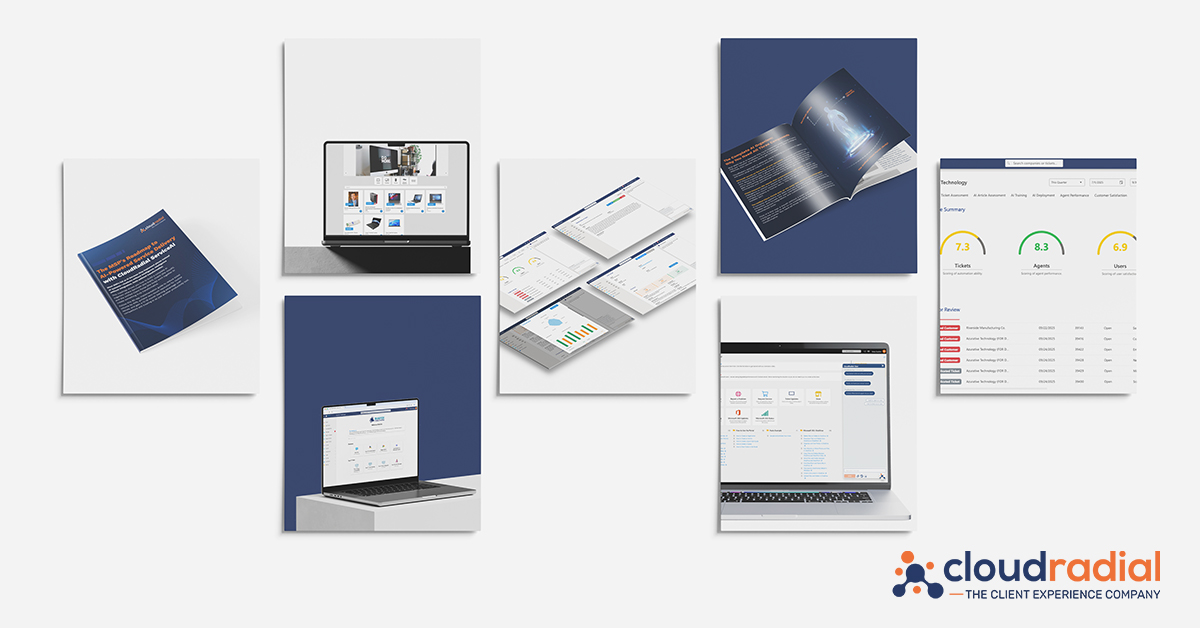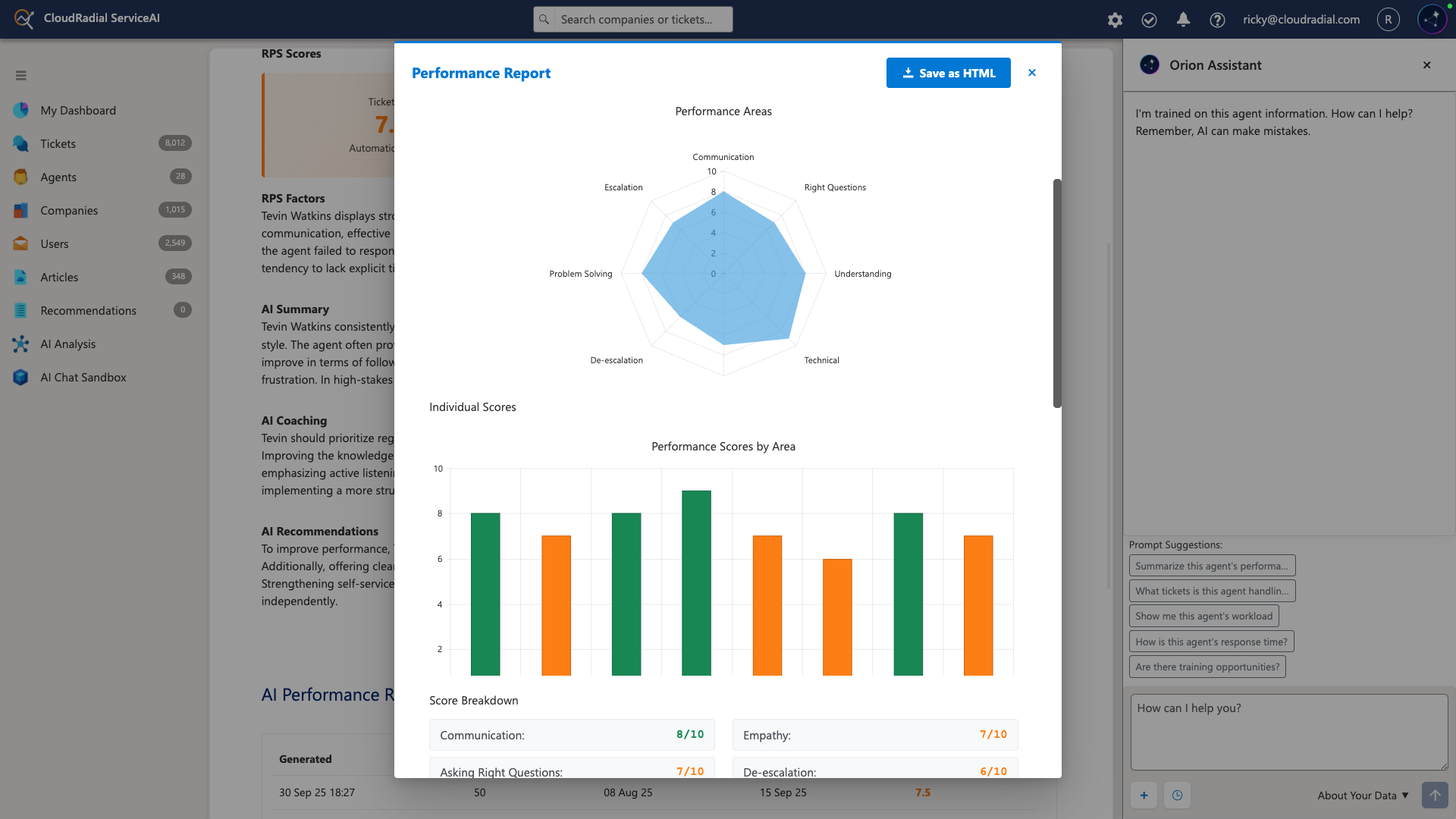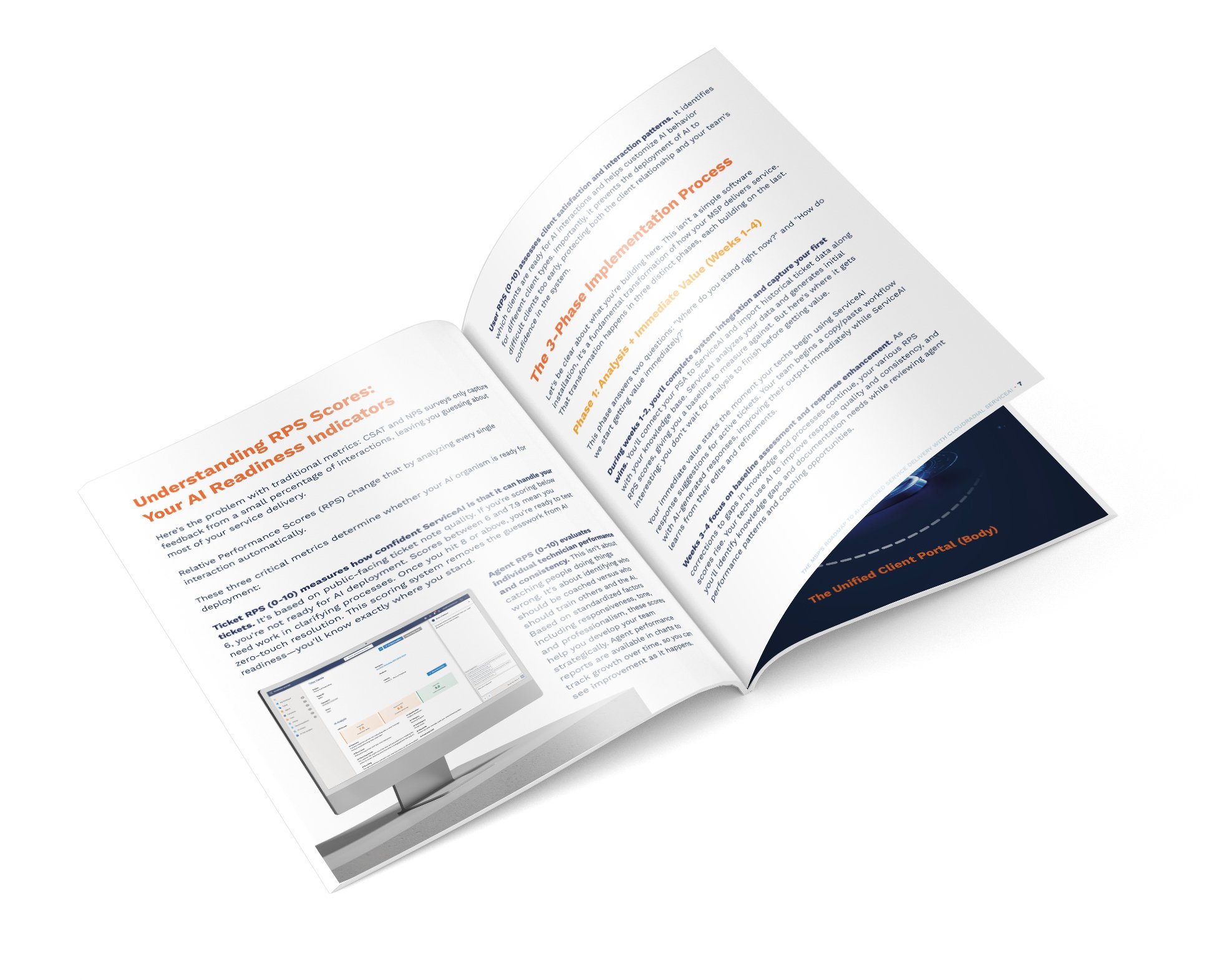CloudRadial 2025: The Year MSPs Stopped Experimenting with AI and Started Transforming
As we close out 2025, it's clear that this was CloudRadial's most transformative year yet. We didn't just release new features—we fundamentally...
Get everything you need for the ultimate client experience
Enterprise-grade infrastructure with the flexibility MSPs demand
Perfectly tailored AI that knows your specific MSP

Build your own Shopify-like store with your PSA products & distributors
Have clients to submit tickets directly to your PSA, freeing up your team's time
Pre-triage and route tickets correctly with the help of AI
Deliver instant, accurate answers that can help achieve zero-touch resolution
You'll learn things like how to add revenue without adding cost, MSP best practices, and how to master client management.
9 min read
Ricky Cecchini : September 3, 2024

When most people talk about the “back of the house” and “front of the house”, the first thing that comes to mind is restaurants. But the same metaphor applies to MSPs.
The back deals with the preparation and delivery of the services, while the front deals with the customer experience.
For MSPs, the service delivery is often an absolute masterpiece of automation and connectivity.
Entire stacks of IT solutions are strategically selected based on interdependence and data flow. From the PSA to the RMM, or backup appliances with security solutions.
MSPs understand what is best for the needs of their clients, and the right tools can help them achieve scalable and effective service delivery. Still, it’s important to remember that while the tools work to facilitate the job, they aren’t really what’s driving the service.
Rather, that is the MSP's own collective experience and intellectual property. That is their secret to their “back of the house”.
The same is true of the “front of the house” – aka, the customer experience (CX). The CX is often the more neglected of the two because it’s not nearly as easy or straightforward to automate. After all, it inherently deals with people and their variable needs.
These people and their needs change often, so getting the CX right usually feels like trying to hit a constantly moving target.
So how can MSPs deliver the same caliber of strategy and intellectual property to their CX as they do with their service delivery?
The first step is to find a platform that can serve as the single pane of glass to help keep CX in focus – at CloudRadial, we have created a client-focused platform for exactly that purpose. Using a shared platform between the client and the MSP allows for transparency and collaboration that would otherwise be next to impossible to achieve.
But the truth is that a platform isn’t inherently going to do anything by itself.
Just like for service delivery, individual tools can facilitate the standardization and improvement of the CX, but they won’t do the job by themselves. Mixing superb account management and human interaction with a shared platform is the key to making the job infinitely more scalable.
Let’s map out the necessary areas in CX to see what MSPs need to make it all work effectively.
CX covers every aspect of the engagement with the MSP, from the very first introduction to the ongoing retention of the account.
A great, modern CX in the era of instant information means giving the client access to focused details on the most important parts of the engagement whenever the client wants.
With the right portal at your disposal, that scope becomes achievable.
Optimizing the client’s journey as they engage with you should be consistent, customizable, and scalable at every stage.
Or, to put it simply, your CX must be consistently great for small clients and big clients alike.
We have broken down the core areas that clients need to have a solid experience with your business.
Start with sales
Offer support
Add value with an intranet
Include catalog transparency
Showcase reporting
Build a roadmap
CX starts with sales at every business – think about the experience of buying an Apple laptop versus a Dell laptop. While the Dell laptop may have superior technical specs, a huge part of the appeal of the Apple laptop is the CX that the user will get with it.
Apple makes it a point to deliver a potent CX, and that earns them a huge following for both their products and their brand. From the packaging to the support, Apple is crafted to be a unique user-centric experience. And often, it even gives them an edge – allowing them to command higher prices among a dependable customer base.
The same strategy can be applied to an MSP. Usually, the first introduction to the MSP’s CX is in the sales process. There is a period of assessments and introductions where the MSP scopes out and recommends the service implementation for the prospective customer.
This is a vital time to show clients what the MSP can offer in terms of visibility, collaboration, and accountability. Until the MSP starts the service delivery, the sales pitch may seem identical to others, down to the same solutions stack used. It’s tough to tell them apart on paper.
That’s why showing the client not just what you’ll do for them, but how they’ll see and interact with it, can do wonders for making a theoretical experience more tangible.
It’s one of the biggest benefits of having your own branded client portal. With a portal at your disposal, you can tangibly walk them through how you’ll deliver the service, as well as how they’ll see it being delivered.
Many MSPs will offer some form of support to their clients. The opportunity for a good CX is huge here, too – as an MSP, you need a platform in which you can facilitate both the submission and visibility of logged support tickets. Many PSAs will have their own ticketing portal that does that - and next to nothing more. It leaves a lot to be desired on the client side.
This leaves many MSPs to seek alternatives that can help make the ticketing experience both more visually appealing and more user-friendly.
CloudRadial, for example, allows you to build entire ticket catalogs so that you can help narrow down and focus the triaging efforts to ultimately resolve tickets faster. In CloudRadial, the client logs the ticket, and the ticket gets sent over to the PSA with all the information necessary to start the resolution process – no more time wasted in back-and-forth email exchanges.
Suddenly, putting forth a bit of extra effort can drastically reduce resolution time to tickets from the clients, as well as giving added visibility with all their ticket history in one consolidated area.
While the benefits are clear, keep in mind that it’s not just an instant win. Ticketing portals come with their own challenges.
Ticketing by itself isn’t an appealing thing for clients – it needs to be part of a greater context within the overall CX. 99% of portals that offer only a single function end up being more hassle to access and interact with than the benefit from actually using them.
So, ticketing can be great for an MSP’s CX – but only if it’s a feature and NOT the whole thing.
Level up your ticketing experience for your service desk and clients with CloudRadial Chat
A good CX can (and should) include things that aren’t explicitly stated within the confines of a contract. If the purpose of driving a good experience is to engage and educate the client in various different ways, then adding value to the way that the client works is a no-brainer.
 In CloudRadial, the approach to CX was to create a platform with built-in features that a non-technical, everyday user would find helpful. That includes things like an application launch menu, a built-in knowledge base, a university training area, and more.
In CloudRadial, the approach to CX was to create a platform with built-in features that a non-technical, everyday user would find helpful. That includes things like an application launch menu, a built-in knowledge base, a university training area, and more.
Why did we put them in there?
Because these intranet features keep the client coming back to the portal for their own needs.
Suddenly, the portal isn’t just an area to log pain-point tickets or see a window into things that are going wrong. It’s a valuable hub that stands independently.
Users can access and add to it, making it fresh with new content and variable as the business grows.
This is arguably the most critical part because it makes the portal sticky. And that’s great CX.
This also makes it much more effective for client retention – when the client relies on you for IT services AND to facilitate their work processes, it’s hard to shift over to another MSP even if they happen to charge less for their services.
Or, to call back an analogy from earlier – MSPs can become Apple instead of remaining Dell.
MSPs face a unique challenge in comparison to other businesses – how do you show your clients all the services you can offer once they are in the door as a customer?
After the MSP identifies their initial needs and provides solutions to fulfill them, the service offerings have a tendency of stopping there.
There isn’t an easy way for the client to engage with other services and offerings the MSP can bring to the table as they grow their business.
 But with the right portal, the CX opportunity there is clear; a portal can give the MSP a way to showcase the entire service catalog easily and visually in a streamlined and user-friendly way, 24/7.
But with the right portal, the CX opportunity there is clear; a portal can give the MSP a way to showcase the entire service catalog easily and visually in a streamlined and user-friendly way, 24/7.
Think about any major service provider – from e-commerce sites like Amazon to utility providers like the electricity company. These organizations allow you to both see the status of your engagement with them (from billing to previous orders) while also keeping up to date with other things they can offer.
From CX perspective, a service catalog can be huge. And, thanks to other companies, it’s become an expected part of a CX.
An MSP can now increase their revenue potential simply by making it easier to buy from them, which helps the client have power in the relationship.
It’s also an easy revenue opportunity for the MSP – the client can just pick what they need, when they want. No need to wait for an upsell opportunity.
At CloudRadial, we put the service catalog front and center for the clients to see. Anything from onboarding forms to laptop orders (and everything in between) is fair game for the catalog. And, because we know starting from scratch is horrid, we’ve got plenty of sample catalog items to use.
Reporting isn’t the first thing that most people think of when discussing CX. However, for MSPs, reporting is critical. It offers proof as to what the MSP is doing for the client while also serving as a basis for technology recommendations.
Imagine how much easier it is for the client to go to one central location for everything – ticketing, service catalog, their intranet, and reporting. Suddenly, the MSP has a singular pane of glass to show the client the work that they do for them. That makes the CX of interacting with the MSP easier than it’s ever been before.
Still, like everything else we’ve discussed, reporting can’t live in a vacuum by itself.
One of the biggest CX challenges that the modern MSP faces is showcasing reporting in an organized way for the client. It can be a challenge to not overwhelm them with technical data.
What the clients need is a way to have the reports at their disposal when they are needed, but an easy overview to focus on the big picture when they’re not.
A platform like CloudRadial improves CX dramatically by offering a launch pad to dive into technicality, without necessarily showcasing it front and center.
 Fully-customizable client dashboard for reporting
Fully-customizable client dashboard for reporting
CloudRadial offers a way for the client to get an overview of their engagement with the MSP, while also giving the client access to things like report archives and interactive dashboards.
The client can get the big picture from the native overviews, or they can dive into deeper reporting through the data sources that the MSP can connect in. Suddenly, the reporting experience becomes consistent from the most nontechnical client to the most technical.
Offering a modern reporting experience that can support both should be a feather in the cap of any modern MSP CX.
No more drowning in useless info – now, it’s just the things that matter.
Business relationships hinge on the ultimate success of both parties. That’s especially true for MSPs that are trying to guide and advise their clients on how to approach technology as a strategy to grow and scale their business.
That’s why a huge part of the CX is the often dreaded “QBR” – the quarterly business review.
Why do MSPs dread it?
Because it’s so variable – there’s not a template or one-size-fits-all strategy that works for all clients all the time, so scaling the discussion can be a huge challenge.
Methodologies surrounding the QBR change drastically depending on who you ask, but the core concept is the same. Make time to talk to your clients and help them understand how to reduce risk, save money, or even make money.
Read: What QBRs Should Be
There’s great CX for the client there, and there is a massive revenue opportunity for both the clients and the MSP. And while the concept is understood, many MSPs still struggle to pull it off.
The pitfall that most fall into is using the QBR as a defensive strategy.
The tendency is to pull together all available reports and defend their right to do business with the client. But most clients do not really care about reviewing last month’s ticket reports or the status of the quarter’s backups.
What they really want to know is how the relationship will take them forward.
Having the ability to lay out a roadmap that shows the client what you have done, what you can do, and what you’re doing is critical. Adding to the CX of a single pane of glass, you are giving them visibility on your thought process and consultation on the sum of their tech management.
CloudRadial’s built-in roadmap allows the MSP to showcase stack services to a client in a way that makes sense from a business strategy perspective. The client can also collaborate on the roadmap with the MSP, making the QBR a collaboration rather than a lecture – which is much better for engagement.
Once the MSP takes an objective look at their CX, they will notice where they’re struggling the most. Maybe it’s in one of the 6 specific areas we’ve identified, or maybe it’s in all of them.
Maybe it’s in one that isn’t mentioned here – because it didn’t exist at the time of writing.
As we said earlier, the challenge is that it’s a constantly moving target. With as fast as technology changes, the CX must adapt to meet the client’s demands and to keep them engaged at every step.
The MSP solution stack and service delivery may also change drastically from today to tomorrow – so having a platform that can roll with the punches on both sides of the coin is critical to CX success.
That’s where CloudRadial comes in, especially since it was built on these exact principles.
Once the MSP defines and builds their CX within CloudRadial with just as much attention and care as their regular service delivery, they’ll be able to deliver the scalable, superior CX to the clients, regardless of size, with unique touches along the way.
Having a platform that can evolve to constantly adapt to new technologies as they emerge, coupled with new features added regularly, can be a massive advantage over other MSPs.
With CloudRadial, your CX can become as powerful as your service delivery.
Get started for just $95/month and see how a CX platform like CloudRadial can change the way that your MSP does business for good.

As we close out 2025, it's clear that this was CloudRadial's most transformative year yet. We didn't just release new features—we fundamentally...

Your service desk manager pulls up the dashboard and smiles. Response times are down 35%. Tickets per technician are up 22%. Documentation time has...

Most AI implementations fail because they're treated like software installations instead of business transformations.